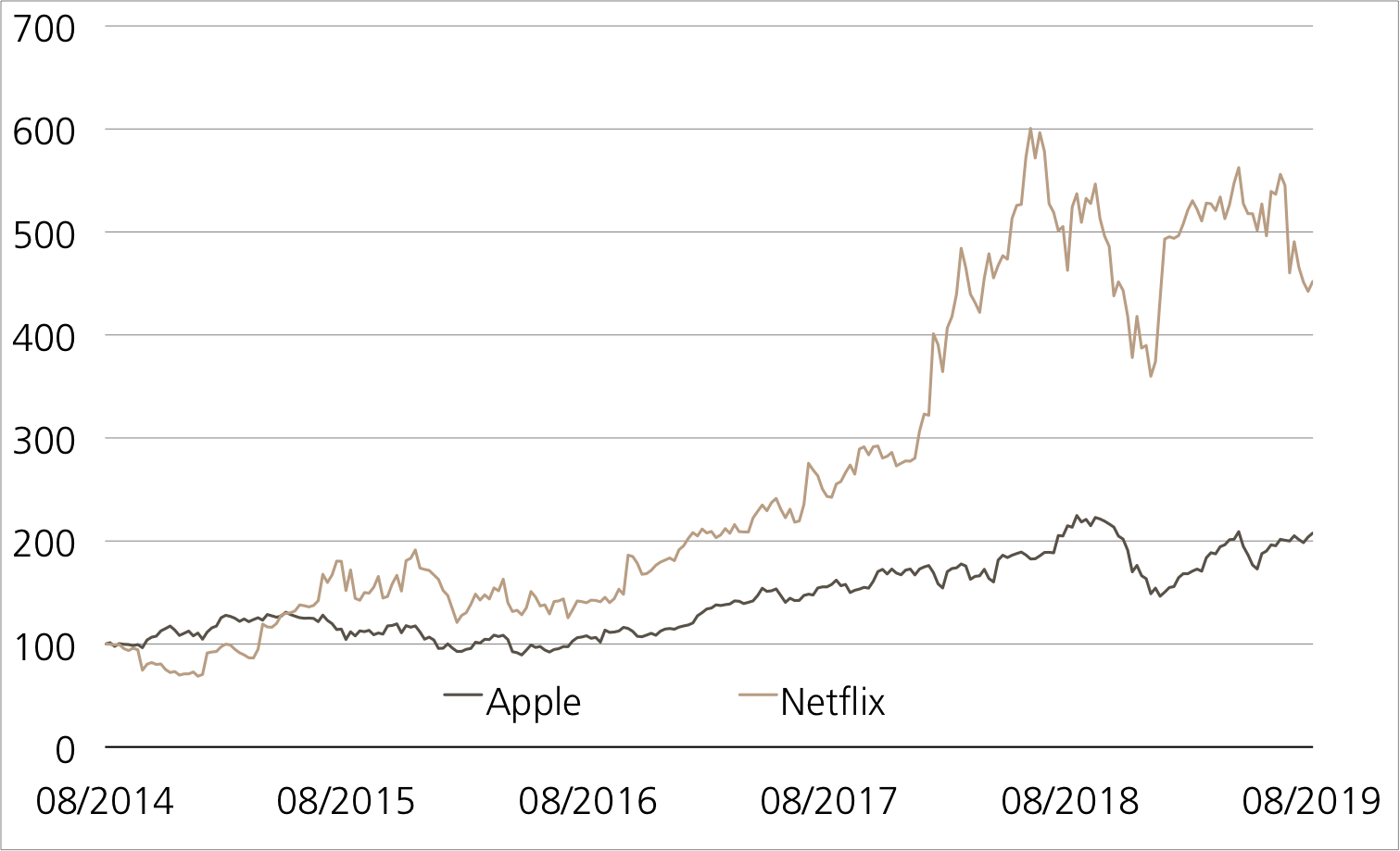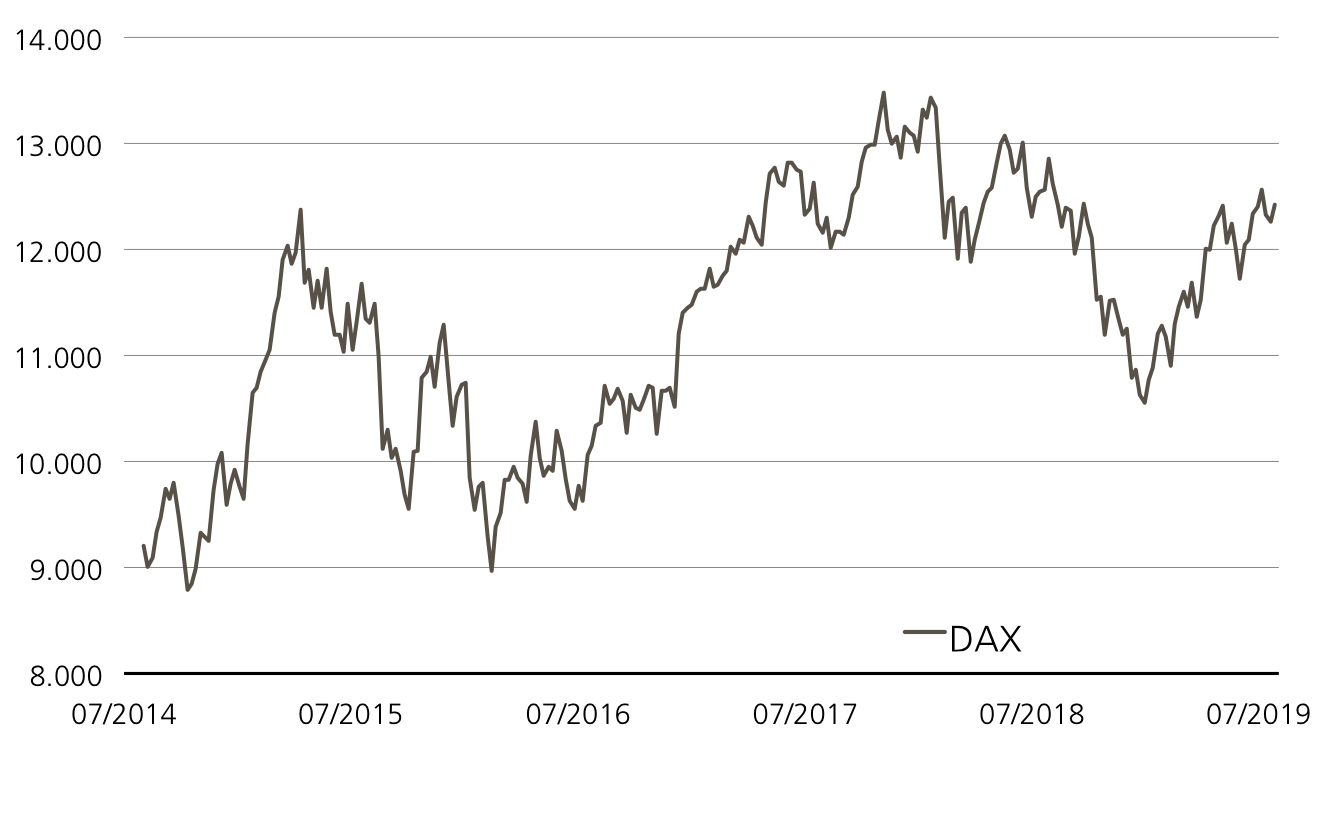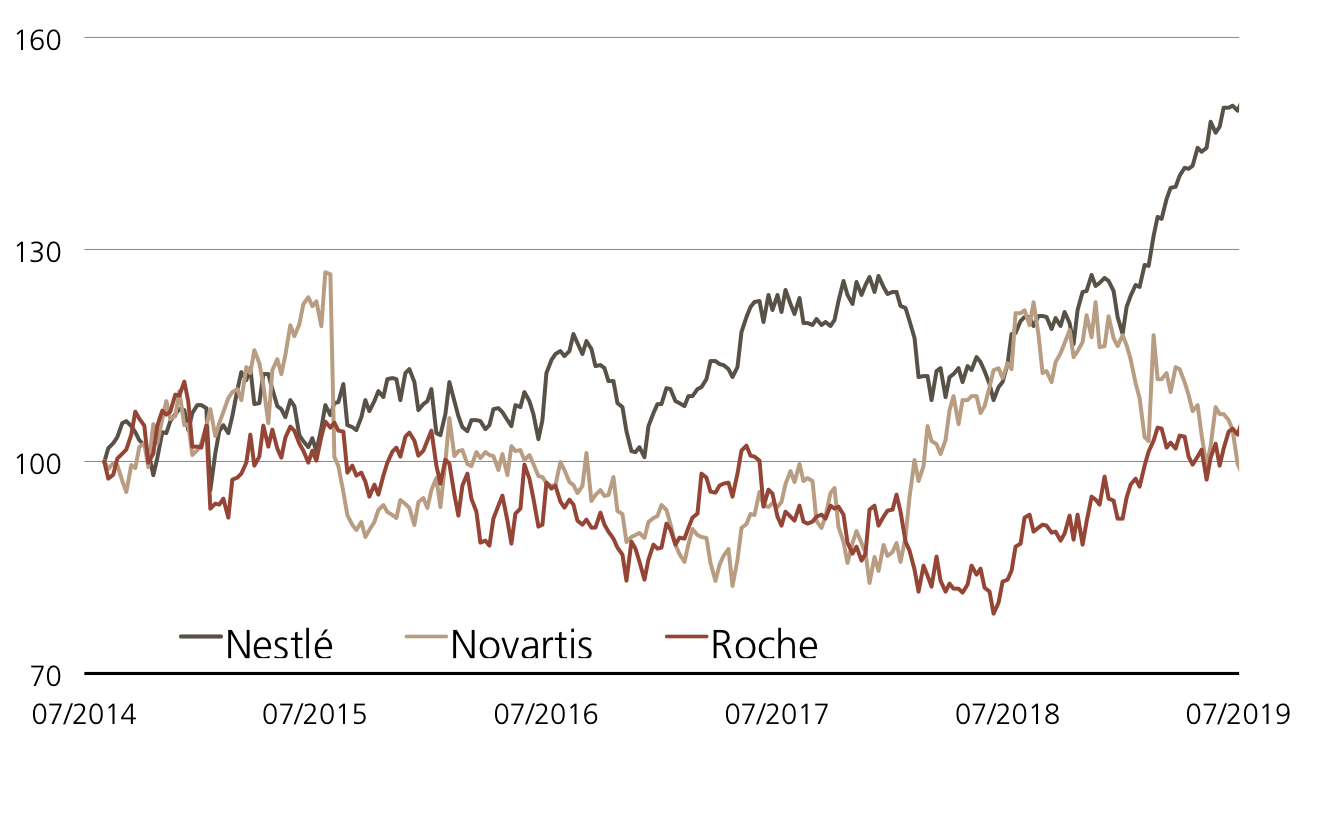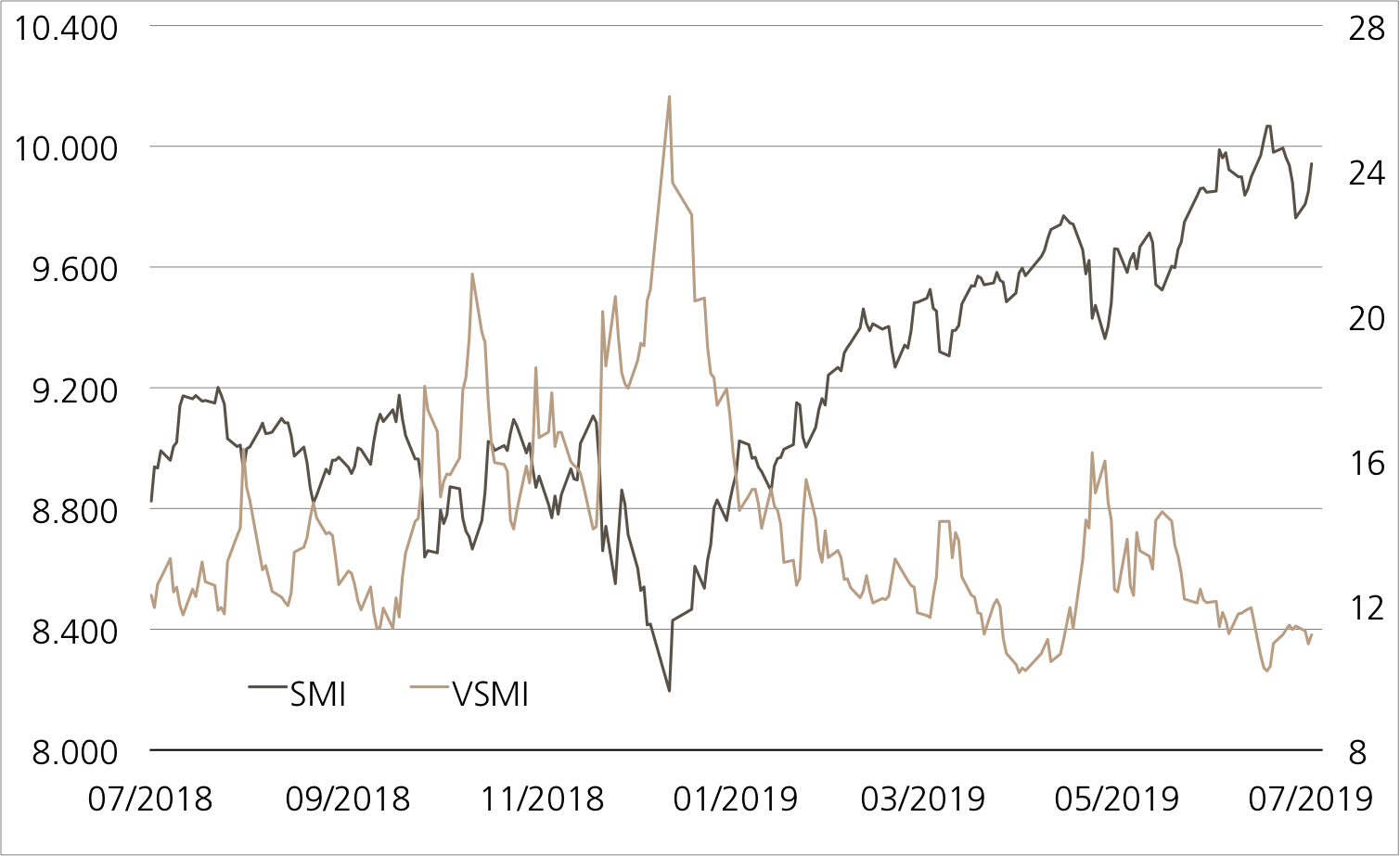Weekly-Hits: Schweizer Aktienmarkt & Software-Giganten

- Thema 1: Schweizer Aktienmarkt – Das volle Programm
- Thema 2: Software-Giganten – Ein innovatives Trio
- Thema 3: Rohstoffmonitor – August 2019
Schweizer Aktienmarkt
Das volle Programm
Heute und morgen geben sich die Top-Manager im Dorint Airport-Hotel die Klinke in die Hand. Auch in diesem Jahr sind viele Unternehmen der Einladung zur «Best of Switzerland Conference» in Opfikon-Glattbrugg gefolgt. Aus dem SMI™ Index präsentieren sich unter anderem die beiden Pharmakonzerne Roche und Novartis oder die Versicherer Swiss Life und Zurich Insurance. Hinzu kommen jede Menge Mid und Small Caps. Beispielsweise halten Clariant, Flughafen Zürich, Partners Group oder Sonova bei dem viel beachteten Anlass die SMIM™-Fahne hoch.
Auch wenn die Verantwortlichen bei ihren Präsentationen gezielt auf den Geschäftsverlauf und die Strategie des jeweiligen Unternehmen eingehen dürften: An der Konferenz werden mit Brexit und Handelsstreit auch die derzeit zwei bestimmenden Themen des Börsengeschehens eine wichtige Rolle spielen. Möglicherweise erhalten die Teilnehmer etwas mehr Klarheit darüber, ob und inwieweit diese Belastungsfaktoren die Geschäfte der häufig international agierenden Schweizer Unternehmen beeinflussen. Pünktlich zum Start in dieKonferenz hat das Staatssekretariat für Wirtschaft aktuelle Zahlen zur makroökonomischen Lage vorgelegt. Am 5. September um 07:45 Uhr (nach Redaktionsschluss dieser Ausgabe) veröffentlichte das SECO die Schätzung des Bruttoinlandsprodukts für das zweite Quartal 2019. In den ersten drei Monaten des Jahres hatte sich die heimische Wirtschaft noch robust entwickelt. Das BIP nahm gegenüber dem Vorquartal um 0.6 Prozent und auf Jahresbasis sogar um 1.4 Prozent zu. Das SECO führte diese Entwicklung in erster Linie auf eine anziehende Inlandsnachfrage zurück. Hinzu kamen positive Impuls vom Aussenhandel. (Quelle: SECO, Medienmitteilung, 28.05.2019)
Seit dieser Publikation hat sich das konjunkturelle Umfeld sukzessive eingetrübt. Dieser Entwicklung haben die Aktien-Analysten mit vielfach reduzierten Gewinnschätzungen Rechnung getragen. Gleichwohl kann sich die Zwischenbilanz des Schweizer Aktienmarktes sehen lassen. Obwohl der SMI™ sich nicht im fünfstelligen Kursbereich halten konnte, notiert der Leitindex 17 Prozent über dem Niveau von Ende 2018. Für den SMIM™ steht sogar ein Plus von rund einem Fünftel zu Buche.¹ Beide Benchmarks profitierten davon, dass viele heimische Unternehmen gut mit den internationalen Wirren zurechtkommen. Das gilt nicht zuletzt für die beiden Indexschwergewichte, Nestlé respektive Partners Group.
Chancen: Anleger, die gerade mit Blick auf das mehr denn je bestehende Tiefzinsumfeld diversifiziert auf den heimischen Aktienmarkt setzen möchten, bietet die UBS verschiedene Produktlösungen an. Auf der Total Return-Variante des SMI™ Index basiert ein ETT (Symbol: ETSMI). Für diese Struktur fällt eine Verwaltungsgebühr von 0.25 Prozent p.a. an.² Ohne laufende Kosten kommt das Tracker-Zertifikat (Symbol: SMMPR) auf den SMIM™ Price Index aus. Beide Strukturen partizipieren ohne Laufzeitbegrenzung am jeweiligen Basiswert.
Risiken:Die vorgestellten Produkte sind nicht kapitalgeschützt. Sowohl beim ETT als auch beim Open End PERLES kommt es zu Verlusten, sobald der zugrundeliegende Index fällt. Zudem trägt der Anleger bei Strukturierten Produkten das Emittentenrisiko, so dass das eingesetzte Kapital – unabhängig von der Entwicklung des Basiswertes – im Falle einer Insolvenz der UBS AG verloren gehen kann.


²) Die Konditionen der ETTs werden jährlich überprüft und können mit einer Frist von 13 Monaten nach Bekanntgabe angepasst werden
| Index | Stand | Woche¹ | |
|---|---|---|---|
| SMI™ | 9’894.60 Pkt. | 1.4% | |
| SLI™ | 1’503.65 Pkt. | 1.8% | |
| S&P 500™ | 2’937.78 Pkt. | 1.7% | |
| EURO STOXX 50™ | 3’450.83 Pkt. | 2.5% | |
| S&P™ BRIC 40 | 4’089.48 Pkt. | 3.3% | |
| CMCI™ Compos. | 876.14 Pkt. | 0.8% | |
| Gold (Feinunze) | 1’560.40 USD | 0.7% | |

Software-Giganten
Ein innovatives Trio
Vor allem die internetbasierte Auslagerung von Dateien und Applikationen entpuppt sich immer mehr als Wachstumstreiber für die Softwareindustrie. Einen aktuellen Beleg für diese These liefert Salesforce. Das auf Lösungen für das Customer Relationship Management (CRM) spezialisierte Unternehmen steigerte im zweiten Quartal des Fiskaljahres 2020 den Umsatz mit Cloud-Anwendungen um 12.5 Prozent auf 1.13 Milliarden US-Dollar. Damit steuerte die grösste Sparte rund ein Drittel zu den Konzernerlösen bei. Nach dieser positiven Entwicklung gab das Management eine über den bisherigen Analysten-Erwartungen liegende Prognose ab. (Quelle: Thomson Reuters, Medienbericht, 22.08.2019)
Während die Salesforce-Aktie mit einem Kurssprung auf den Zwischenbericht reagierte, kamen die jüngsten Zahlen von SAP bei den Investoren nicht gut an.¹ Wegen hoher Ausgaben für Abfindungsprogramme und die jüngsten Zukäufe verbuchte Europas grösster Softwarekonzern im zweiten Quartal einen Rückgang beim Betriebsergebnis. Auf der Umsatzseite legte SAP dagegen kräftig zu. Dabei ragte die Cloud-Sparte mit einem Wachstum von 40 Prozent heraus. Ab dem kommenden Jahr möchte CEO Bill McDermott auch bei der Profitabilität wieder deutliche Fortschritte erzielen. (Quelle: Thomson Reuters, Medienbericht, 18.07.2019) Etwas aus dem Tritt geraten ist auch die Oracle-Aktie, nachdem der US-Large Cap im Juli ein Allzeithoch erreicht hatte.¹ Wie es dem Konzern zuletzt operativ ergangen ist, erfahren Anleger am 16. September. Dann legt Oracle die Zahlen für das erste Quartal der Geschäftsperiode 2019/20 vor.
Chancen:Auf einen in etwa stabilen Kursverlauf von SAP, Oracle und Salesforce zielt der neue Callable Kick-In GOAL (Symbol: KEDUDU) ab. Solange kein Basiswert während der Laufzeit auf oder unter die Barriere bei 55 Prozent der jeweiligen Anfangsfixierung fällt, wirft das Produkt die Maximalrendite von 10.25 Prozent p.a. ab. Möglicherweise müssen Anleger keine 24 Monate auf dieses Resultat warten. UBS kann die Emission zu den im Termsheet bestimmten Terminen kündigen.
Risiken:Kick-In GOALs sind nicht kapitalgeschützt. Notiert einer der Basiswerte während der Laufzeit einmal auf oder unter dem jeweiligen Kick-In Level (Barriere) und kommt zudem das Callable Feature nicht zum tragen, kann die Tilgung am Verfalltag durch Bartilgung entsprechend der (vom Strike aus) schwächsten Performance aus dem Trio erfolgen (höchstens jedoch zum Nominalwert zuzüglich Coupon). In diesem Fall sind Verluste wahrscheinlich. Zudem trägt der Anleger bei Strukturierten Produkten das Emittentenrisiko, so dass das eingesetzte Kapital – unabhängig von der Entwicklung des Basiswertes – im Falle einer Insolvenz der UBS AG verloren gehen kann.

10.25% p.a. Callable Kick-In GOAL auf SAP / Oracle / Salesforce
| Remove | ||
|---|---|---|
| Symbol | KEDUDU | |
| SVSP Name | Barrier Reverse Convertible | |
| SVSP Code | 1230 (Callable) | |
| Basiswerte | SAP, Oracle, Salesforce | |
| Handelswährung | USD | |
| Coupon | 10.25% p.a. | |
| Kick-In Level (Barriere) | 55% | |
| Verfall | 13.09.2021 | |
| Emittentin | UBS AG, London | |
| Zeichnung bis | 11.09.2019, 15:00 Uhr | |
Termsheet Weitere Produkte sowie Informationen zu Chancen und Risiken finden Sie unter: ubs.com/keyinvest Quelle: UBS AG Stand: 04.09.2019
²) Die Konditionen der ETTs werden jährlich überprüft und können mit einer Frist von 13 Monaten nach Bekanntgabe angepasst werden
Rohstoffmonitor
August 2019

Total-Return-Performance der UBS Bloomberg CMCI Einzelrohstoff-Indizes im August 2019 in US-Dollar.
Stand: 31.08.2019Quelle: UBS AG

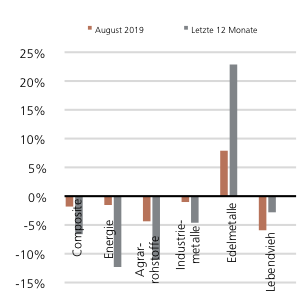
| Produkt | Symbol | Währung | Monatsperformance¹ | Anteil am Gesamtvolumen | |
|---|---|---|---|---|---|
| 2x Short Factor Certificate on CMCI WTI | OIL2S | USD | 7.6% | 13.6% | |
| UBS ETC on CMCI Gold | EGCCI | EUR | 7.2% | 12.5% | |
| 2x Long Factor Certificate on CMCI WTI | OIL2L | USD | -15.0% | 8.9% | |
| UBS ETC on CMCI Composite | TCMCI | USD | -4.2% | 7.7% | |
| UBS ETC on CMCI Gold | CGCCI | CHF | 7.3% | 7.5% | |
| UBS ETC on CMCI Nickel | TLNCI | USD | 24./% | 6.4% | |
| UBS ETC on CMCI Brent Crude | TCOCI | USD | -8.8% | 6.2% | |
| UBS ETC on CMCI WTI Crude Oil | ECLCI | EUR | -7.2% | 6.1% | |
| UBS ETC on CMCI WTI Crude Oil | TCLCI | USD | 7.8% | 5.9% | |












